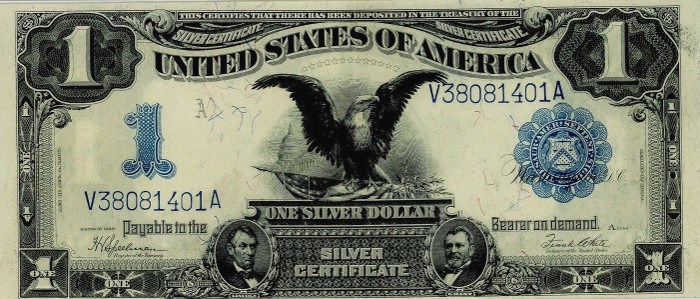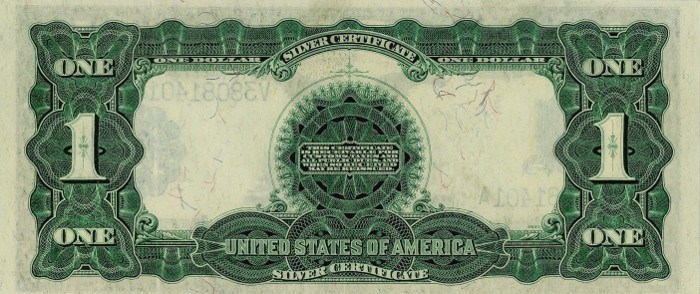The 1899 one dollar certificates are collectible, but they aren't very valuable. Although these notes are old, they are still fairly common because many of them were printed over a two decade span. It's the most common large note after the 1923 one dollar silver certificate note.
Most coin shops who deal with currency will have at least a few on hand. This is good if you are looking to buy, but not if you are looking to sell.
The design of this bill is unlike any bill ever produced. Instead of having a portrait in the center of the bill, it has a picture of a black eagle. So that's why it's called the "black eagle note". Underneath the eagle you can see small portraits of Abraham Lincoln and Ulysses Grant. This is the only bill to have portraits of two different presidents.


Specifications
| Denomination: | $1.00 U.S. Dollar |
| Series: | 1899 |
| Type: | Silver Certificate |
| Note Size: | Large |
| Portrait: | Abraham Lincoln and Ulysses Grant |
| Varieties: | 13 |
How Much Is Your Bill Worth?
Like most old currency, the value is mainly going to depend on condition. Most 1899 $1 silver certificates are worth around $100 in very good condition. In very fine condition the value is around $165-180. In extremely fine condition the value is around $250-315. Uncirculated bills with a grade of MS 63 can sell for around $525-625.
The values are subject to change based on market demand. The 1899 one dollar silver certificate fluctuates in value more than other one dollar silver certificates due to its rarity. For example the value of the 1928 one dollar silver certificate bill is more stable.
Click here to search for 1899 silver certificates on Amazon.
Rare Signature Combinations
Signature combinations can play a factor with regards to value. For this note there are 11 different signature combinations, but only two of them are rare.
One valuable combination is the No. 229a black eagle with the signatures of Vernon and McClung. This bill is worth around $250 in very good condition. In very fine condition the value is around $600. In extremely fine condition the value is around $1,750. Uncirculated bills with a grade of MS 63 can sell for around $6,500.
The other rare combination is the No. 231 black eagle with the signatures of Napier and Thompson. This bill is worth around $150 in very good condition. In very fine condition the value is around $60. In extremely fine condition the value is around $1,000. Uncirculated bills with a grade of MS 63 can sell for around $3,500.
Additional Factors That Can Increase the Value
Since many of these bills were produced, there are different serial number combinations available. These combinations include block serial numbers and low serial numbers. For this particular note a lot of low serial numbers have been saved. A bill with a unique serial number is going to be worth more money.
Lastly there are also several "courtesy autographs" out there. A courtesy autograph is a note signed by the same treasury official whose name appears on the note. It's difficult to determine the value of a courtesy autograph note because they are rare, and the autographs need to be authenticated.
Grading System
Very good- A circulated note that has considerable wear to it. There might be one or two tears on the edge of the note. The note may be discolored, dark in appearance, or limp.
Very fine- A note that has been in circulation but not for a long time. The note is still relatively crisp. There may be some creases, folds, or light smudges.
Extremely fine- A note that shows small signs of having been in circulation. The note will be bright and it will have almost all of its original crispness. There might be one or two minor creases or folds but there are no stains, discolorations, or tears.
MS 63 choice uncirculated- A note that shows no signs of ever having been in circulation. The note still has its original crispness. The note is also well-centered.
Conclusion
This 1899 note is a nice bill to own and it can be quite valuable depending on condition and the signature combination. If you have one of these bills then we recommend placing it into a large-size currency holder. This currency holder will keep the bill safe and secure.
Sources:
